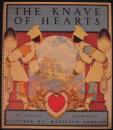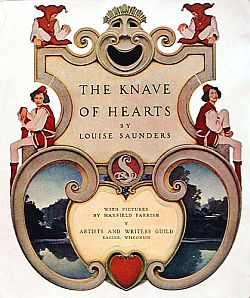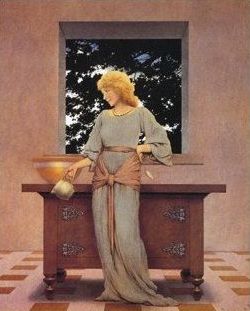To the truly dedicated lover of art, the works of Maxfield Parrish rank at a culminating pinnacle. Indeed, to fix one’s gaze on Parrish’s wondrous illustrations is to escape into a magical world of whimsy, charm, and, as is characteristic of Parrish’s works, a delightful dash of humor. It should come as no surprise then, that art lovers and rare book lovers alike deem Louise Saunders’ fable Knave of Hearts as the truest and most poignant depiction of Parrish’s incredible capability as an artist and illustrator.
The collaboration of Saunders’ impeccable literary talent and Parrish’s artistic genius fuse together to create a mesmerizingly kaleidoscopic look at one of the most underrated characters in Lewis Carroll’s Alice’s Adventures in Wonderland: The Knave of Hearts. Through Parrish’s lively illustrations and Saunders’ melodic text, readers are enchantingly encapsulated into an addendum of the much beloved world of Wonderland with some quirky and humorous twists.
One need only open to the first page of Knave of Hearts to be delighted and transfixed with Parrish’s illustrations, which seem to be set in motion. Instantly the reader is transported to the very heart of the spine thrilling and trepidating action of court life in the King and Queen of Heart’s realm. Even at a quick glance the reader is swiftly acquainted with the immense sense of fear, urgency and question which prevails within the castle, while simultaneously exploring the lush and rolling landscape of Wonderland, which sets an ameliorative backdrop to the horror and trauma which resonates from the King and Queen’s domain.
So astounding are Parrish’s artistic works, that there is now an acclaimed exhibit at the National Museum of American Illustration in Newport, Rhode Island, which depicts his resplendent illustrated works. Indeed, according to the website, visitors have come from far and wide to view the collection of Parrish’s works, coming from as far as China, the United Kingdom, Italy, the Czech Republic, Sweden and South Korea.
While it may seem surprising that individuals from so many distant lands opted to make the pilgrimage to the museum, Parrish’s incredible works deem the trek well worthwhile. In fact, Parrish put so much effort into his works that he took three years simply to create the illustrations for Knave of Hearts. With only the most precise and articulate brushstrokes, Parrish slowly created the twenty-six illustrated masterpieces which the fable consists of, and even constructed an intricate castle replica, to use as a muse for his illustrations of the castle of the King and Queen of Hearts. Moreover, Parrish brought a personal touch to the illustrations by incorporating household items from his own home onto the pages.
When it came to creating his wonderful illustrations for Knave of Hearts, nothing was too pretentious or costly for Parrish. When it was published in 1925, Knave of Hearts was printed on costly, heavily coated paper, and the bright illustrations were of the highest reproduction quality available, casting the illusion that they were indeed the original works. The first edition was issued in 1925 by Charles Scribner’s Sons, as a softcover which was spiral bound, as well as a hardcover without a dust jacket. Pricing varies between the two formats, as well as the condition which they are in. On average a good copy costs around $1,000 with finer copies priced at much higher amounts. While still a bit costly, it is truly the entrance to a world of intricate whimsy, delight, exquisite illustration and transportative verse.



{ 3 comments… read them below or add one }
Thank you for sharing your knowledge of this piece.
The spiral bound edition was apparently printed sometime in the 1930s by a different publisher and was not contemporary with the original 1925 Scribner’s edition.
The 1925 first edition hardcover was issued with a glassine dust jacket in a two-piece black paper covered box with a gold printed label on the lid.